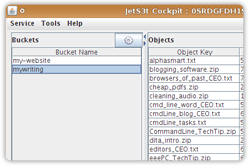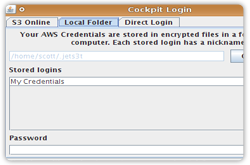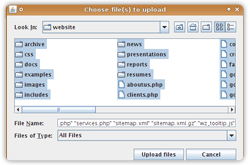Files. They tend to multiply on your hard drives faster than you can keep up with them. To be safe, you’ll want to backup many of those files. A good way to to do that is with an external hard drive, as discussed in a previous TechTip.
However, you might not be able to justify the expense of an external drive — you might not have enough files to put even a small dent in a drive’s storage capacity. Or, you might want to have access to the files from wherever you are and not have to worry about lugging (or losing) a CD or a USB flash drive.
One alternative is to use online storage. For a fee, you can store files on a secure site and get to them from anywhere.You can find a list of 90 online storage services here. However, some of them can be expensive, and they may have limited capacity. The average seems to be about 5 MB.
If you’re looking for a service that’s inexpensive and offers a large capacity, then you might want to check out S3.
Taking a closer look
An offering of Amazon.com, S3 is short for Simple Storage Service. Using S3, you can easily store and retrieve your files, and even make them available to friends, family, business associates, and clients.
According to its description, S3 “is designed to make web-scale computing easier for developers.” It’s popular with the providers of Web-based applications, including firms like SmugMug, 37 Signals, GigaVox Media, and many others. But it’s not just for developers, as you’ll learn a little later. Anyone can use S3 to save their important files, like documents and photos.
The good
The two most attractive features of S3 are the available storage capacity and its price. The amount of data that you can store is practically limitless. Amazon.com hasn’t given an upper limit, but the ordinary user will probably never max it out.
The monthly fee for using S3 is 15 to 18 cents per megabyte that you store. Yes, you read that correctly — 15 to 18 cents per megabyte. Unless you plan to store hundreds of megabytes of files (or more), you’ll find that S3 is quite possibly the cheapest option out there.
The not-so-good
S3 isn’t perfect, and some people will find the following to be drawbacks. By using the service, you’re putting your files and information into the hands of someone else. While S3 is said to be secure, that doesn’t mean that malicious individuals can’t break in.
While the service is quite reliable, outages can happen. One occurred in February, 2008. While it didn’t last as long as a Blackberry outage that happened at the same time, the S3 outage affected a large number of people.
Using S3
To get an S3 account, you need to sign up at the S3 Web site. The process is a bit easier if you already have an account with Amazon.com.
You’ll notice that there’s no interface to upload files to S3. Remember that it’s a developer’s tool, and developers are expected to work their programming magic to connect to the service. That said, some of those developers created programs that could directly connect to S3 — in the same way as you’d connect to a Web site using an FTP client.
 There are a number of command line tools for accessing S3, as well as some good graphical ones. If you use the Firefox Web browser, then you might want to take a look at the S3Fox add-on. JungleDisk is an interesting piece of software that creates something akin to a virtual drive on your computer, from which you upload to S3. Bucket Explorer acts like a file manager, allowing you to transfer and manipulate the files that you copy to your S3 buckets. JetS3T Cockpit is a simple but easy to use interface to S3 that can run on multiple operating systems.
There are a number of command line tools for accessing S3, as well as some good graphical ones. If you use the Firefox Web browser, then you might want to take a look at the S3Fox add-on. JungleDisk is an interesting piece of software that creates something akin to a virtual drive on your computer, from which you upload to S3. Bucket Explorer acts like a file manager, allowing you to transfer and manipulate the files that you copy to your S3 buckets. JetS3T Cockpit is a simple but easy to use interface to S3 that can run on multiple operating systems.
I’ve worked with several S3 clients, and had varying success with them. Some, I couldn’t get to work. Others were slow. The one I use is JetS3T Cockpit. It’s written in Java, so it runs on my Linux and Windows computers. It’s easy to use, and it’s free. The rest of this TechTip looks at using JetS3T Cockpit to back files up to an S3 account.
 Working with JetS3t Cockpit
Working with JetS3t Cockpit
Get going by downloading and installing JetS3t Cockpit. When you start it, you’re asked for login credentials for S3. The credentials consist of an access key and a secret key. To view these keys, log into S3 and then click the AWS Access Identifiers link on the main S3 page. On the AWS Access Identifiers page, your credentials are on the right-hand side.
You can save your credentials on your computer, or configure JetS3t Cockpit to automatically log you in. If you have multiple S3 accounts, then saving your credentials locally is a good idea.
 When you log in, you’ll notice that the JetS3t Cockpit window is divided into two panes. The left pane will list your buckets. A bucket is simply a collection of files (called objects), sort of like a file folder on your computer. In addition to files, a bucket can also hold directories. Each file in a bucket can be up to 5 GB in size, although I don’t expect many ordinary users will have files that large. The right pane will list the files in each bucket.
When you log in, you’ll notice that the JetS3t Cockpit window is divided into two panes. The left pane will list your buckets. A bucket is simply a collection of files (called objects), sort of like a file folder on your computer. In addition to files, a bucket can also hold directories. Each file in a bucket can be up to 5 GB in size, although I don’t expect many ordinary users will have files that large. The right pane will list the files in each bucket.
 Now what? Once you’re logged in, you can create one or more buckets. To create a bucket, click the gear icon in the left pane and select Create New Bucket. Type a name for your bucket in the dialog box that appears and then click OK.
Now what? Once you’re logged in, you can create one or more buckets. To create a bucket, click the gear icon in the left pane and select Create New Bucket. Type a name for your bucket in the dialog box that appears and then click OK.
From there, you can upload files to a bucket by clicking on the gear icon in the right pane, and then selecting Upload file(s). A file selector dialog box appears. You can choose a single file, multiple files, or entire directories. Once you’ve chosen the files that you want to store in S3, click Upload files. Depending on the number of files that you are transferring, their size, and the speed of your Internet connection, the upload can take anywhere from a few seconds to a few minutes. While writing this TechTip, I uploaded about 12 MB of files into a single bucket. The transfer took three minutes.
 If you need to download one or more files from a bucket, just right click on it and choose Download object(s) from the menu that appears. You will be prompted for a location to download the files. Then, click Choose Directory to transfer the file.
If you need to download one or more files from a bucket, just right click on it and choose Download object(s) from the menu that appears. You will be prompted for a location to download the files. Then, click Choose Directory to transfer the file.
You can delete a file or view its properties by right clicking on the name of the file and selecting an option from the menu that pops up. If you want to make a file accessible to friends or family, right click on the file and then select Generate Public GET URL from the menu that appears. You’ll be prompted for the number of hours that you want to make the file available for (the default is 30 minutes), then S3 generates a Web address for the file, which looks like this:
https://s3.amazonaws.com/myFolder/somefile?AWSAccessKeyId=
01234abdadlj&Expires=1204077366&Signature=MQL5dr5jze
JGRoHdC%2FtFgR00g0%3D
You can only generate a URL for one file at a time using JetS3t Cockpit. You can, however, download or delete multiple files.
Conclusion
S3 is a solid, inexpensive, and simple way to store, share, and backup you files. Depending on your level of comfort, you might not want to use S3 to store your sensitive information, but for anything else S3 is definitely a good addition to your Web-based tool kit.